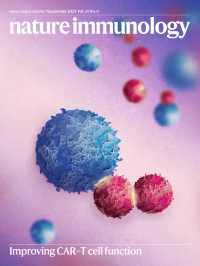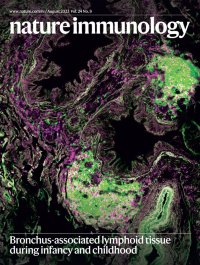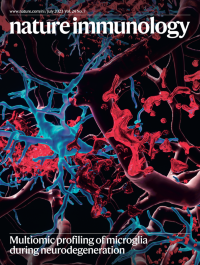Volume 24
-
No. 12 December 2023
Cancer immunology and immunotherapyNature Immunology has commissioned a series of Reviews to make sense of interactions between immune cells and cancer cells, highlighting the value of spatial and other omic technologies for analysis of the tumor microenvironment, immune cell dysfunction and how to counter it to enhance CAR-based and other immunotherapies, and more.
See:
-
No. 11 November 2023
Newborn and child-like molecular T cell signatures in older adultsKedzierska and colleagues use single-cell profiling of T cells across the human lifespan to show that a suboptimal T cell receptor (TCR) shift in T cells as we enter old age results in a molecular signature that resembles that of T cells from newborns and children.
See Kedzierska et al.
-
No. 10 October 2023
The microenvironment of glioblastoma tumorsChen and colleagues show that TFPI2 promotes the self-renewal of glioblastoma stem cells (GSCs) and connects stemness to microglia immunosuppression. In addition, targeting TFPI2-mediated GSC–microglia symbiosis inhibits tumor growth and synergizes with anti-PD-1 therapy in glioblastoma.
See Chen et al.
-
No. 9 September 2023
Improving CAR–T cell functionChimeric antigen receptor (CAR) T cells may become exhausted, non-functional or deplete their target cells of antigen, limiting their efficacy. Chen and colleagues fuse the cytoplasmic tail of CTLA-4 to the C terminus of CAR, which compromises trogocytosis and increases the functional capacity of CAR–T cells.
See Chen et al.
-
No. 8 August 2023
Bronchus-associated lymphoid tissue during infancy and childhoodYoung children frequently encounter respiratory pathogens that elicit immune responses in developing lungs. Farber and colleagues examine rare lung tissue samples obtained from pediatric organ donors, and find age-dependent formation of bronchus-associated lymphoid tissue (BALT), which peaks at age 3 and dissipates thereafter. Single-cell profiling of BALT lymphocytes indicates repertoire and functional differences between B cells in the lung, lung-associaed lymph nodes and circulating cells.
See Farber et al.
-
No. 7 July 2023
Multiomic profiling of microglia during neurodegenerationAkassoglou and colleagues provide single-cell RNA-sequencing and phosphoproteome analyses of CNS microglia and macrophages in response to blood proteins including activated complement and fibrin. Their findings point to potential therapeutic targeting of microglia activation by immune and vascular signals.
See Akassoglou et al.
-
No. 6 June 2023
Comorbidities alter antibody responses to COVID-19 vaccineKedzierska and colleagues examine the response to SARS-CoV-2 mRNA vaccines in Australian First Nations people, a population with a high burden of comorbidities. The artwork depicts the organs affected by chronic disease as five large dots (for heart, liver, kidneys, lungs and brain), surrounded by bush medicine leaves and smaller dots representing the researchers and health professionals sharing information.
See Kedzierska et al.
-
No. 5 May 2023
NK cell-intrinsic sex differencesCheng et al. show that an extra copy of the X-linked epigenetic regulator UTX in female mice increases natural killer (NK) cell effector function. As NK cells are crucial for antiviral immunity, this may explain decreased severity of viral infections in female versus male mammals.
See Cheng et al.
-
No. 4 April 2023
Colonic γδ T cells and psychosocial stressKamiya and colleagues examine the effects of chronic social defeat stress on the intestinal microbiome and show the pathological role of dectin-1 and interleukin-17 expressed by gut γδ T cells on this behavioral vulnerability.
See Kamiya et al.
-
No. 3 March 2023
Dietary cholesterol influences IgA secretionReboldi and colleagues show that high-cholesterol diets influence the secretion of immunoglobulin A (IgA). Cholesterol-derived metabolites act on plasma cell GPR183 receptors to alter the positioning of IgA+ plasma cells within the lamina propria and suppress antibody responses to intestinal pathogens.
See Reboldi et al.
-
No. 2 February 2023
Programmed early-age iNKT cell skin localizationProper localization and function of immune cells in the skin is crucial for protection and for establishing skin tissue homeostasis. Xiong and colleagues find a developmentally programmed process that directs preferential localization of invariant natural killer T (iNKT) cells into the skin for early local homeostatic regulation.
See Xiong et al.
-
No. 1 January 2023
Ammonia detoxification and CD8+ T cell memoryAmmonia detoxification is generally thought to occur exclusively in the liver. Huang and colleagues show that ammonia detoxification via the urea and citrulline cycles is utilized by memory CD8+ T cells to maintain longevity.
See Tang et al.












